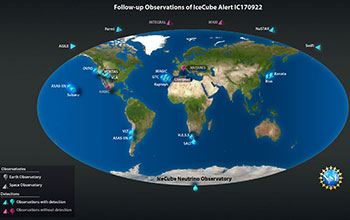Multimedia Gallery
Approximately 20 observatories followed up on IceCube's Sept. 22, 2017, detection
On Sept. 22, 2017, NSF's IceCube Neutrino Observatory alerted the international astronomy community about the detection of a high-energy neutrino. Approximately 20 observatories on Earth and in space made follow-up observations, which allowed identification of what scientists deem to be a source of very high energy neutrinos, and thus, of cosmic rays. Besides neutrinos, the observations made across the electromagnetic spectrum included gamma-rays, X-rays, and optical and radio radiation. The observatories are operated by international teams involving a total of more than 1,000 scientists supported by funding agencies in countries around the world.
Credit: Nicolle R. Fuller/NSF/IceCube
Images and other media in the National Science Foundation Multimedia Gallery are available for use in print and electronic material by NSF employees, members of the media, university staff, teachers and the general public. All media in the gallery are intended for personal, educational and nonprofit/non-commercial use only.
Images credited to the National Science Foundation, a federal agency, are in the public domain. The images were created by employees of the United States Government as part of their official duties or prepared by contractors as "works for hire" for NSF. You may freely use NSF-credited images and, at your discretion, credit NSF with a "Courtesy: National Science Foundation" notation.
Additional information about general usage can be found in Conditions.
Also Available:
Download the high-resolution JPG version of the image. (787.3 KB)
Use your mouse to right-click (Mac users may need to Ctrl-click) the link above and choose the option that will save the file or target to your computer.

